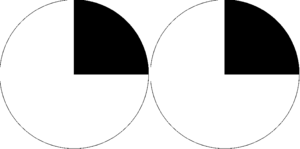Hemianopsia
Hemianopsia, or hemianopia, is a less vision or blindness (anopsia) in half the visual field, usually on one side of the vertical midline. The most common causes of this damage are stroke, brain tumor, and trauma.[1]
| Hemianopsia | |
|---|---|
| Specialty | Ophthalmology, neurology |
This article deals only with permanent hemianopsia, and not with transitory or temporary hemianopsia, as identified by William Wollaston PRS in 1824.[2] Temporary hemianopsia can occur in the aura phase of migraine.
Etymology

The word hemianopsia is from Greek origins, where:
- hemi means "half",
- an means "without", and
- opsia means "seeing".
Types
When the pathology involves both eyes, it is either homonymous or heteronymous.
Homonymous hemianopsia

A homonymous hemianopsia is the loss of half of the visual field on the same side in both eyes. The visual images that we see to the right side travel from both eyes to the left side of the brain, while the visual images we see to the left side in each eye travel to the right side of the brain. Therefore, damage to the right side of the posterior portion of the brain or right optic tract can cause a loss of the left field of view in both eyes. Likewise, damage to the left posterior brain or left optic radiation can cause a loss of the right field of vision.[3]

Heteronymous hemianopsia

A heteronymous hemianopsia is the loss of half of the visual field on different sides in both eyes. It is separated into two categories:
- Binasal hemianopsia – the loss of the fields surrounding the nose;
- Bitemporal hemianopsia – the loss of the fields closest to the temples.
Other forms
- Superior hemianopsia – the upper half of the field of vision is affected, possibly because of a tumor beginning to compress the lower part of the chiasma, typically one from the hypophysis.
- Inferior hemianopsia – the lower half of the field of vision is affected, possibly because of a tumor beginning to compress the upper part of the chiasma, typically a craniopharyngioma.
Quadrantanopia

Quadrantanopia (quadrantanopsia or quadrantic hemianopsia) is decreased vision or blindness in one quarter of the visual field. The particular quarter of vision missing depends on whether the location of the brain damage is temporal or parietal, and the side of the lesion.[4] For example, a lesion to the right temporal lobe with damage specifically to Meyer's loop will give rise to a left upper (superior) quadrantanopsia, while a lesion to the right parietal radiation with damage specifically to Baum's loop will result in a left lower (inferior) quadrantanopsia.[5]
Visual neglect
Visual neglect (also called hemispatial neglect or unilateral spatial neglect) differs from hemianopsia in that it is an attentional deficit rather than a visual one. Unlike patients with hemianopsia who actually don't see, those with visual neglect have no trouble seeing but are impaired in attending to and processing the visual information they receive. Whereas hemianopsia can be assuaged by allowing patients to move their eyes around a visual scene (ensuring that the entire scene makes it into their intact visual field), neglect cannot. Neglect can also apply to auditory or tactile stimuli and can even leave a patient unaware of one side of his or her own body.[6]
Ellis and Young (1998) showed that neglect can also affect patients' mental maps such that if they are asked to picture themselves standing in a familiar location and name the buildings around them, they will neglect to name the buildings on their impaired side but will be able to name them when asked to mentally face the opposite direction.[7]
Some patients with neglect also have hemianopsia, however the two often occur independent of one another.
Management
Some forms of hemianopia can be treated through repeated presentations of multisensory stimuli due to the process of multisensory integration occurring in the superior colliculus.[8]
Surgical interventions have also been shown to ameliorate certain forms of hemianopia due to counterbalancing brain lesions due to a process known as the Sprague effect.[9]
References
- Hemianopia (Hemianopsia), helpforvisionloss.com
- Gazzaniga, Michael; Ivry, Richard; Mangun, George (2013). Cognitive Neuroscience: The Biology of the Mind (4th ed.). W. W. Norton & Company. pp. 9. ISBN 978-0393913484.
- "eye, human." Encyclopædia Britannica. Encyclopædia Britannica Ultimate Reference Suite. Chicago: Encyclopædia Britannica, 2010.
- "Archived copy". Archived from the original on 30 March 2012. Retrieved 3 October 2011.CS1 maint: archived copy as title (link)
- Toronto Notes 2011, pg. N21
- Caramazza, A.; Hillis, A. E. (1990). "Spatial representation of words in the brain implied by studies of a unilateral neglect patient". Nature (Letter). 346 (6281): 267–269. doi:10.1038/346267a0. PMID 2374591.
- Ellis, A. W. & Young, A. W. (1988). Human cognitive neuropsychology. Hove, UK: Erlbaum. Visual Extinction and Unilateral Neglect & Denial (pp. 76-79).
- Jiang, Huai; Stein, Barry E.; McHaffie, John G. (29 May 2015). "Multisensory training reverses midbrain lesion-induced changes and ameliorates haemianopia". Nature Communications. 6: 7263. doi:10.1038/ncomms8263. ISSN 2041-1723. PMC 6193257. PMID 26021613.
- Sprague, James M. (23 September 1966). "Interaction of Cortex and Superior Colliculus in Mediation of Visually Guided Behavior in the Cat". Science. 153 (3743): 1544–1547. doi:10.1126/science.153.3743.1544. ISSN 0036-8075. PMID 5917786.
- O'Neill, E., O'Connor, J., Brady, J., Reid, I., and Logan, P. Prism Therapy and Visual Rehabilitation in Homonymous Visual Field Loss. 2011 Optometry and Vision Science, Vol. 88, No 2 February 2011.
- Giorgi, RG., Woods, RI., Peli, E. Clinical and Laboratory Evaluation of Peripheral Prism Glasses for hemianopsia. Optometry and Vision Science 2009; 86: 492-502.